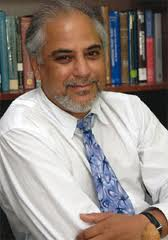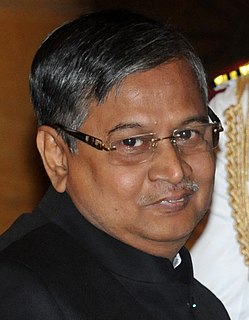
The Deutsches Elektronen-Synchrotron, commonly referred to by the abbreviation DESY, is a national research center in Germany. It operates particle accelerators used to investigate the structure of matter, and conducts a broad spectrum of inter-disciplinary scientific research in three main areas: particle and high energy physics; photon science, and the development, construction and operation of particle accelerators. Its name refers to its first project, an electron synchrotron. DESY is publicly financed by the Federal Republic of Germany, the States of Germany, and the German Research Foundation (DFG). DESY is a member of the Helmholtz Association and operates at sites in Hamburg and Zeuthen.
A collider is a type of particle accelerator which brings two opposing particle beams together such that the particles collide. Colliders may either be ring accelerators or linear accelerators.

A synchrotron is a particular type of cyclic particle accelerator, descended from the cyclotron, in which the accelerating particle beam travels around a fixed closed-loop path. The magnetic field which bends the particle beam into its closed path increases with time during the accelerating process, being synchronized to the increasing kinetic energy of the particles. The synchrotron is one of the first accelerator concepts to enable the construction of large-scale facilities, since bending, beam focusing and acceleration can be separated into different components. The most powerful modern particle accelerators use versions of the synchrotron design. The largest synchrotron-type accelerator, also the largest particle accelerator in the world, is the 27-kilometre-circumference (17 mi) Large Hadron Collider (LHC) near Geneva, Switzerland, built in 2008 by the European Organization for Nuclear Research (CERN). It can accelerate beams of protons to an energy of 6.5 tera electronvolts (TeV or 1012 eV).

Raja Ramanna was an Indian physicist who is best known for his role in India's nuclear program during its early stages.

The Bhabha Atomic Research Centre (BARC) is India's premier nuclear research facility, headquartered in Trombay, Mumbai,Maharashtra. Founded by Homi Jehangir Bhabha Atomic Energy Establishment, Trombay (AEET) in January 1954 as a multidisciplinary research program essential for India's nuclear program. It operates under the Department of Atomic Energy (DAE), which is directly overseen by the Prime Minister of India. In 1966 after the death of Mr. Bhabha, AEET was renamed as Bhabha Atomic Research Centre (BARC).

The Homi Bhabha National Institute (HBNI) is an Indian deemed university established by the Department of Atomic Energy, which unifies academic programmes of several of its constituent institutions. Deemed universities in India have been divided in three categories by the Ministry of Human Resource Development (MHRD) and HBNI has been placed in category 'A', highest of the three categories. Homi Bhabha National Institute, Mumbai and its Constituent Units are the institutions of excellence as per section 4(b) of "The Central Education Institutions Act, 2006".

The Indian Laser Association (ILA) is an association of persons interested in laser technology and applications. The ILA is non-profit multidisciplinary professional organization. The association aims to promote education, advancement and applications of laser science and technology in India, through various activities such as organization of seminars, symposia and training courses; publications of books and journals; and promotion of active interaction with other professional institutions especially in the field of medicine and engineering.

The Department of Atomic Energy (DAE) is a department with headquarters in Mumbai, Maharashtra, India. DAE was established in 1954 by a Presidential Order. DAE has been engaged in the development of nuclear power technology, applications of radiation technologies in the fields of agriculture, medicine, industry and basic research. DAE comprises five research centres, three industrial organisations, five public sector undertakings and three service organisations. It has under its aegis two boards for promoting and funding extramural research in nuclear and allied fields, mathematics and a national institute. It also supports eight institutes of international repute engaged in research in basic sciences, astronomy, astrophysics, cancer research and education. It also has in its fold an educational society that provides educational facilities for children of DAE employees. The important programmes of the DAE are directed towards:
The Atomic Energy Commission of India is the governing body of the Department of Atomic Energy (DAE), Government of India. The DAE is under the direct charge of the Prime Minister.

Swapan Chattopadhyay CorrFRSE is an Indian American physicist. Chattopadhyay completed his PhD from the University of California (Berkeley) in 1982.

A particle accelerator is a machine that uses electromagnetic fields to propel charged particles to very high speeds and energies, and to contain them in well-defined beams.

The Abdus Salam Centre for Physics, is a federally-funded research institute and national laboratory site managed by the Quaid-i-Azam University for the Ministry of Energy (MoE) of the Government of Pakistan.
Padmanabhan Krishnagopala Iyengar, was an Indian nuclear physicist who is widely known for his central role in the development of the nuclear program of India. Iyengar previously served as the director of BARC and former chairman of the Atomic Energy Commission of India, he raised his voice and opposition against the nuclear agreement between India and the United States and expressed that the deal favoured the United States.
Indus-2 is a synchrotron radiation source with a nominal electron energy of 2.5 GeV and a critical wavelength of about 1.98 angstroms. It is one of the most important projects in progress at the Raja Ramanna Centre for Advanced Technology. It is designed to cater to the needs of X-ray users, material scientists and researchers. Indus-1 has the distinction of being the first synchrotron generator of India with a 450 Mev storage ring. Indus-2 is an improvement over Indus-1.

Sekhar Basu was an Indian nuclear scientist who served as the chairman of the Atomic Energy Commission and Secretary to the Government of India, Department of Atomic Energy (DAE). He also served as the Director of Bhabha Atomic Research Centre (BARC), the Project Director of Nuclear Submarine Program and later as the Chief Executive of the Nuclear Recycle Board at BARC. He was a recipient of India's fourth highest civilian honor Padma Shri in 2014.
Chaitanyamoy Ganguly is an Indian nuclear scientist and a former head of the Nuclear Fuel Cycle and Materials Section of the International Atomic Energy Agency (IAEA), credited with many innovations in the field of nuclear material science. He was honored by the Government of India, in 2002, with the fourth highest Indian civilian award of Padma Shri.
Dipankar Das Sarma, popularly known as D.D. Sarma, is an Indian scientist and structural chemist, known for his researches in the fields of Solid State Chemistry, Spectroscopy, Condensed Matter Physics, Materials Science, and Nanoscience. He is a former MLS Chair Professor of Physics and Chairman of the Centre for Advanced Materials and the GAST Professor of Uppsala University, Sweden, A recipient of TWAS Physics Prize and the UNESCO Biennial Javed Husain Prize, Sarma was honored by the Council for Scientific and Industrial Research (CSIR), Government of India, in 1994, with the Shanti Swarup Bhatnagar Prize for Science and Technology.
Jai Pal Mittal is an Indian scientist, DAE Raja Ramanna Fellow of Bhabha Atomic Research Centre and Distinguished Professor of Indian Institute of Technology, Mumbai, the National Academy of Sciences, India and the University of Pune. He is known for his researches in the fields of photochemistry and radiation chemistry. He was honoured by the Government of India in 2003 with Padma Shri, the fourth highest Indian civilian award.
Dilip Devidas Bhawalkar is an Indian optical physicist and the founder director of the Raja Ramanna Centre for Advanced Technology (CAT), an institute under the Department of Atomic Energy, serving as a centre for higher studies in the fields of lasers and particle accelerators. He is credited with pioneering research in optics and lasers in India and is reported to have contributed in making CAT a partner in the International Linear Collider and Large Hadron Collider experiments of the European Organization for Nuclear Research (CERN). He is a recipient of the Shanti Swarup Bhatnagar Prize, the highest Indian award in science and technology. The Government of India awarded him the fourth highest civilian award of the Padma Shri in 2000.
Shyam Sunder Kapoor is an Indian nuclear physicist and a former director of Bhabha Atomic Research Centre. Known for his research on fission and heavy-ion physics, Kapoor is an elected fellow of all the three major Indian science academies – Indian Academy of Sciences, Indian National Science Academy and National Academy of Sciences, India – as well as the Institute of Physics. The Council of Scientific and Industrial Research, the apex agency of the Government of India for scientific research, awarded him the Shanti Swarup Bhatnagar Prize for Science and Technology, one of the highest Indian science awards, for his contributions to Physical Sciences in 1983.











